Wintertime, and the Whiskey is Lazy?
We have stepped with both feet into Winter now that it is January. Starting today, the Bluegrass will dip beneath 32°F and stay there for about 5 days. What is happening inside all of those barrels camping out in their metal (or brick) tents? You can probably take any tour offered on the Kentucky Bourbon Trail™ and hear well-meaning tour guide after well-meaning tour guide explain the same story--that the whiskey spent all of Summer in an expanded state, playing in the wood outside of the charred walls of home (or even evaporating away into that great tumbler in the sky), then, after growing tired from all of that play, retreating back inside to get tucked into its American White Oak bed by Mother Winter.Is it true, as the Van Winkles might say, that whiskey in the Winter is "asleep . . . in the wood"? Yes and no.I am personally familiar with the story, and I have always heard that 45°F is the magic point at which whiskey decides to take its slumber. I never gave that hard number much thought as so many variables can affect the volatility of a liquid. Temperature, humidity and pressure are just a few. Physics teachers will tell you that things expand as they are heated. As temperature drops, those same things contract. Whiskey, therefore, expands into the barrel staves, passing through the char layer in the hotter months, and contracts back through the char layer into the barrel in the colder months. I am sure, scientifically, there is a way that, if you have a few constants like chemical composition, humidity or pressure, you can calculate the exact temperature at which a whiskey will no longer pass through the char layer. Let's save that for someone's thesis.Recently, a member of our group that is in the supply-side of the "industry" was told by an unnamed American whiskey maker that the magic point was 60°F. To me, a 60°F magic point is just too high. If that was the case, the whiskey at Hillrock Estate in Ancram, New York or WhistlePig in Shoreham, Vermont would spend most of the year not "aging." A large portion of this group member's business involves Scotch, and his memories of the weather in Scotland immediately set off alarm bells at such a high magic point. He asked a few experts in the Scotch industry for their thoughts. One shot back this quick quip: "For reference the average warehouse temp in Scotland is 54°F so let's hope global warming kicks in soon so we can start making whisky here at some point." And another had a little more to say:
There is certainly some truth in this statement; in cooler conditions, there is much less wood extraction, higher temperatures tend to drive flavour out of the wood. This is one of the primary reasons that most US whiskies are bottled at much younger ages than Scotch malt.
It is, not, however, true to say that the whisky lies 'dormant'; there are degrees of oxidative ageing, which while not driving wood-derived flavours, will result in the production of many molecules giving fragrance and complexity, such as di-ethyl acetal, which is responsible for some of the herbal/minty notes in whisky.
If conditions are also damp, this helps encourage oxidative ageing. And for what this is worth, I believe that Yoichi is my favourite Japanese whisky because in Hokkaido, where the stock is aged, conditions are cooler and damper than in Honshu, the main island of Japan, hence Yoichi's Scotch-like complexity.
But those comments are only good for Scotland and Japan, right? What about in Kentucky where so much of the world's bourbon spends its days?Reid Mitenbuler, in his book Bourbon Empire: The Past and Future of America's Whiskey, devotes a page to information provided by Brown-Forman's Master Distiller Chris Morris that might support the argument that whiskey goes "dormant" in the colder months. Chris Morris noted, as Reid put it in "very general terms," that some barrels in the Brown-Forman warehouses have temperature probes that will turn on a heating system once the temperature inside the barrels dips to, get this, 60°F!¹ At the same time, Chris Morris says, "Hot or cold, you have material from the wood being absorbed by the spirit."²Jim Rutledge recently dropped into a Four Roses tribute group on Facebook to matter-of-factly give his thoughts on, among other things, the idea of whether whiskey will go "dormant" during colder months. Here is what Jim thinks: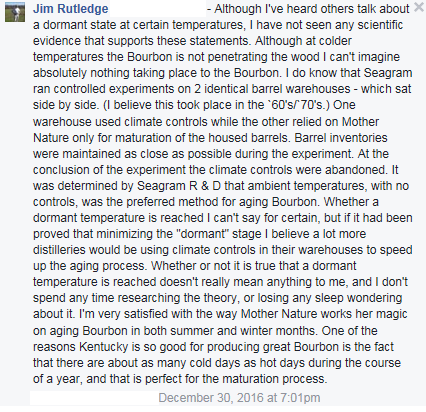 Maker's Mark seems to agree with Chris Morris that, hot or cold, the whiskey will pull some flavor from the wood. Just look at Maker's 46, which is aged in barrels containing suspended French oak staves toasted to the specifications of Recipe No. 46 and, until recently, was only aged in the cooler months. Now, Maker's Mark is building a limestone cellar to age Maker's 46 in a cooler environment year round.So, "dormant" or not, whiskey does not stop evolving. You cannot flip a switch and turn chemistry on or off.What does happen to whiskey during the colder months? You'd be surprised, but that is a tale for another day. ¹Mitenbuler, Reid. Bourbon Empire: The Past and Future of America's Whiskey. New York, NY: Penguin Books; 2015, p. 151.²Id.
Maker's Mark seems to agree with Chris Morris that, hot or cold, the whiskey will pull some flavor from the wood. Just look at Maker's 46, which is aged in barrels containing suspended French oak staves toasted to the specifications of Recipe No. 46 and, until recently, was only aged in the cooler months. Now, Maker's Mark is building a limestone cellar to age Maker's 46 in a cooler environment year round.So, "dormant" or not, whiskey does not stop evolving. You cannot flip a switch and turn chemistry on or off.What does happen to whiskey during the colder months? You'd be surprised, but that is a tale for another day. ¹Mitenbuler, Reid. Bourbon Empire: The Past and Future of America's Whiskey. New York, NY: Penguin Books; 2015, p. 151.²Id.
Cocktail Accessory Review: BDX Cocktail Cube
I heard about the Booker & Dax Cocktail Cube recently, and speaking as an enormous fan of everything Dave Arnold (the bar, the book, the Searzall) I knew that I had to pick one up.If you didn't click on the link, the Cocktail Cube has a great backstory, and I'll let Mr. Arnold tell it himself.
For years I scoffed at the numerous bartenders I heard wax poetic on the virtues of shaking cocktails with one big ice cube. One year in front of a large audience I ran a test intended to prove that big ice cubes were all show. I shook with different types of ice and dumped the drinks into graduated cylinders to measure the amount of foam the shaking had produced. To my surprise, and embarrassment, the large cube had a positive, repeatable effect on foam quantity. I don’t know why the big cube does a better job, it just does.
The Cocktail Cube is a 2-inch block of high density polyethylene which feels exactly like an ice cube in the shaker. Large ice cubes are a luxury, and wasting them on a shaken cocktail is not ideal, so the idea here is that you put the cube in the shaker alongside the cocktail and other ice.Obviously I couldn't just take his word on it (although honestly I definitely could, the man is a genius) so I ran a side-by-side with both a gimlet and a daiquiri with and without the Cube.The bottom line here is that all other things being equal (I made sure to keep both versions identical, down to the number of ice cubes used to shake with) the Cocktail Cube really does affect the viscosity of the drink in a good way. The drinks I shook with the Cube were both lighter-feeling (good for the citrus-based daiquiri and gimlet) and tasted better. I'll be using it in my shaken drinks from now on.
Another Blind Tasting (Part 2) - Smooth Ambler Low Ryes & Buffalo Trace Experimental Wheated
RecapI enjoy doing blind tastings, as you can see HERE, HERE and HERE. The first link and most recent blind tasting relates to a spontaneous blind tasting of low rye private selection Smooth Ambler Old Scout samples and two of the Buffalo Trace Experimental Collection 12 year wheated trio. Again, thanks Steve (aka @jesteva62755).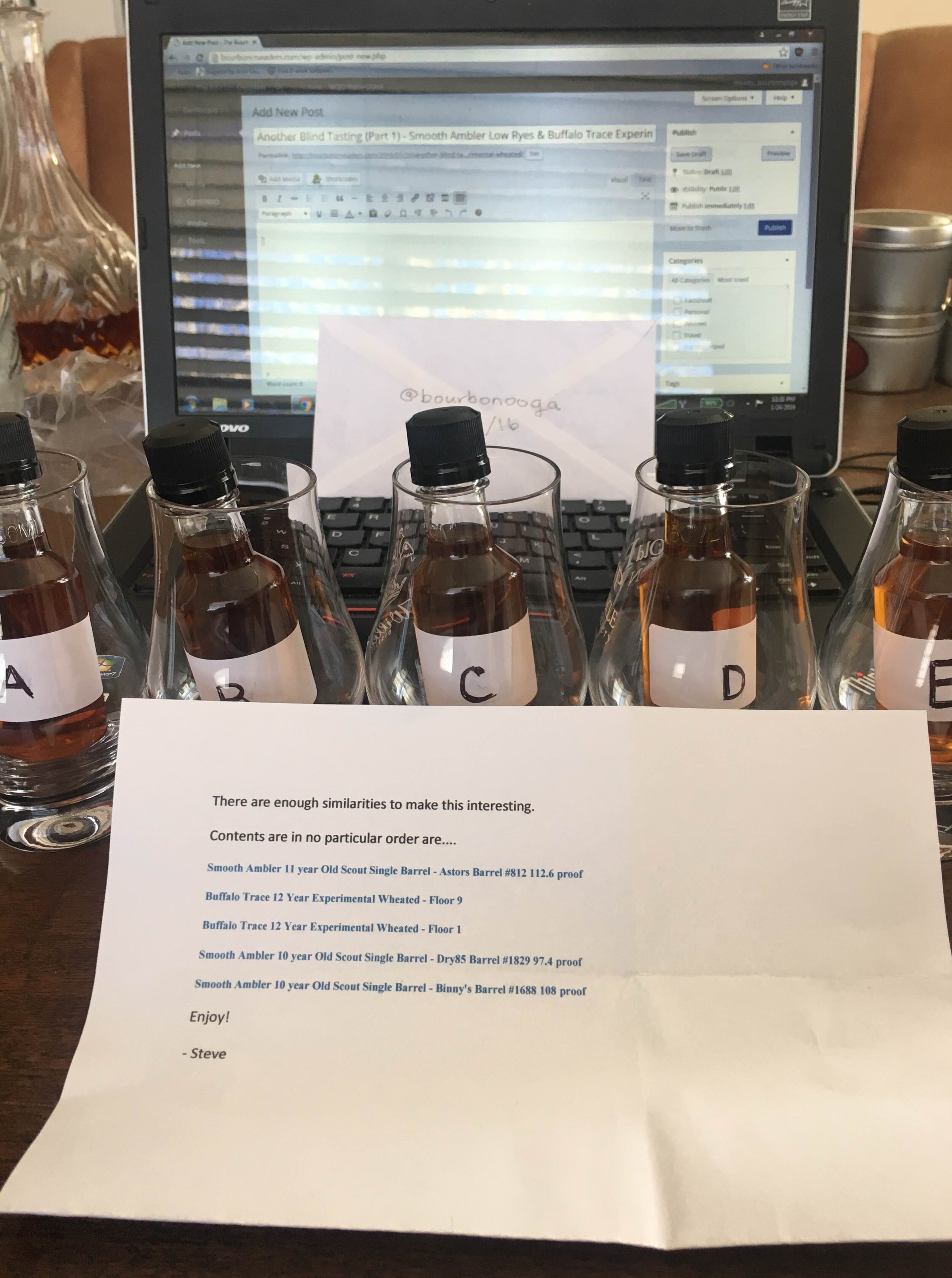 As you can see from the picture above, I knew ahead of time that the five bourbons were, in no particular order:
As you can see from the picture above, I knew ahead of time that the five bourbons were, in no particular order:
- Smooth Ambler Old Scout 11 Year Old – Astor’s Single Barrel #812 (112.6 proof);
- Buffalo Trace Experimental Collection – 12 Year Old Wheated Bourbon from Floor #9 (90.0 proof);
- Buffalo Trace Experimental Collection – 12 Year Old Wheated Bourbon from Floor #1 (90.0 proof);
- Smooth Ambler Old Scout 10 Year Old – Dry85 Single Barrel #1829 (97.4 proof); and
- Smooth Ambler Old Scout 10 Year Old – Binny’s Single Barrel #1688 (108.0 proof).
In Part 1, I gave my background and methodology for this tasting as well as my notes and guesses for each of the five samples. In this Part 2, I will reveal the results and briefly discuss the second part of the blind tasting where I tried to guess the same samples based on memory after my wife randomized the samples from Samples A-E into Samples 1-5. I will close with a few thoughts and lessons learned.Part 1 RevealSample AGuess: Smooth Ambler Old Scout 10 Year Old – Binny’s Single Barrel #1688 (108.0 proof)Result: Smooth Ambler Old Scout 10 Year Old – Binny’s Single Barrel #1688 (108.0 proof)Sample BGuess: Buffalo Trace Experimental Collection – 12 Year Old Wheated Bourbon from Floor #1 (90.0 proof)Result: Buffalo Trace Experimental Collection – 12 Year Old Wheated Bourbon from Floor #9 (90.0 proof)Sample CGuess: Smooth Ambler Old Scout 10 Year Old – Dry85 Single Barrel #1829 (97.4 proof)Result: Smooth Ambler Old Scout 10 Year Old – Dry85 Single Barrel #1829 (97.4 proof)Sample DGuess: Smooth Ambler Old Scout 11 Year Old – Astor’s Single Barrel #812 (112.6 proof)Result: Smooth Ambler Old Scout 11 Year Old – Astor’s Single Barrel #812 (112.6 proof)Sample EGuess: Buffalo Trace Experimental Collection – 12 Year Old Wheated Bourbon from Floor #9 (90.0 proof)Result: Buffalo Trace Experimental Collection – 12 Year Old Wheated Bourbon from Floor #1 (90.0 proof)Obviously, I did not get 100% right. But, I do note that I was able in Part 1 to correctly identify the low rye pours versus the wheated pours. I was also able to discern the proof between Samples A and D against Sample C. My guesses on Samples A and D were simply a coin-toss. After Part 1, I would have ranked the pours something like A > D >> C >> E > B. I would buy a case of the Binny's #1688 if I found it in the wild. ISO!Part 2 RevealIn Part 2, my wife took Samples A-E and poured the last half of each sample into five new glencairns labeled Samples 1-5. She randomized the samples so that Sample A was not necessarily Sample 1 during Part 2. Part 2 took place about 24 hours after Part 1. I decided that the easiest thing would be to pick out the wheated samples from smell alone and to concentrate on those two to decide which might be Floor 1 or Floor 9. After that, I looked primarily to the color and nose to pinpoint Sample A, and I was left with Samples C and D. Sample C during Part 1 had a peculiar taste that I did not get in Part 2. Both Samples C and D improved over the course of the day so my guesses on Samples C and D were almost a coin-toss like with Samples A and D in Part 1, but I was more confident this time around between Samples C and D than I was with Samples A and D in Part 1.Sample 1Guess: Sample A ("definitely Sample A")Reveal: Sample ASample 2Guess: Sample CReveal: Sample CSample 3Guess: Sample B ("definitely BTEC")Reveal: Sample ESample 4Guess: Sample DReveal: Sample DSample 5Guess: Sample E ("definitely BTEC")Reveal: Sample BTherefore, as I did in Part 1, I correctly guessed 3 of the 5, with the two incorrect guesses related to the wheated bourbons.Takeaways from this Blind Challenge
- Steve is a great, generous bourbon brother. This tasting was not the first time that he hit me with a bourbon bomb. He has store credit with me. Bourbon friends are good friends.
- I need a bottle of Binny's #1688. This bottle could easily best any of the four batches of Elijah Craig Barrel Proof that I have tried. This one has a lot in common with great Willett Family Estate bottles in the 10-14 year range or with 2013 or 2015 George T. Stagg cut with water (this may be better than I remember 2014 George T. Stagg). I think this bottle goes to show that MGP can put out a bourbon that would be worthy of many Top 10 lists out there. I stick by my 8.5 to 9.0 range on this bottle--it is at least 8.5, likely 8.75 with a theoretical vacuum limit of 9.25. This one pushed all the right buttons, and I will definitely keep its profile in mind should the Crusaders ever venture to West Virginia.
- I prefer at least 100 proof and some rye in bourbon. I am biased toward big, bold, spicy, rich, dessert-like bourbons at the moment.
- In line with #3, I think it might be easier than one thinks to differentiate no-rye vs. low-rye. Of no-rye, low-rye, high-rye, rye, wheat, or scotch whiskies, I think the hardest distinction is between low-rye vs. high-rye.
- I was shocked to find more oak and wood spice notes in Floor 1 over Floor 9 both days when 7 months ago I correctly found more oak and wood spice in Floor 9 over Floor 5 and then over Floor 1--twice!
- If I tried this challenge again in a week, I think I would correctly find the Binny's #1688 (even without looking at the color) and know which two are the wheated bourbons. I think it would be a coin-toss on the Astor's #812 and Dry85 #1829. Ultimately, averaging both days, I would rank these as Binny's >> Astor's > Dry85 >> Floor 1 > Floor 9.
Till next time, I will just finish this glass of VOB100 6YO and Ginger Beer.
Another Blind Tasting (Part 1) - Smooth Ambler Low Ryes & Buffalo Trace Experimental Wheated
IntroductionI enjoy doing blind tastings. I especially enjoy blind tastings that spontaneously show up in my mailbox. Today, thanks to @jesteva62755 (aka Steve), I am going to do the first of a two-part blind tasting involving low rye, private selection single barrel bourbons from Smooth Ambler and experimental wheated bourbons from Buffalo Trace.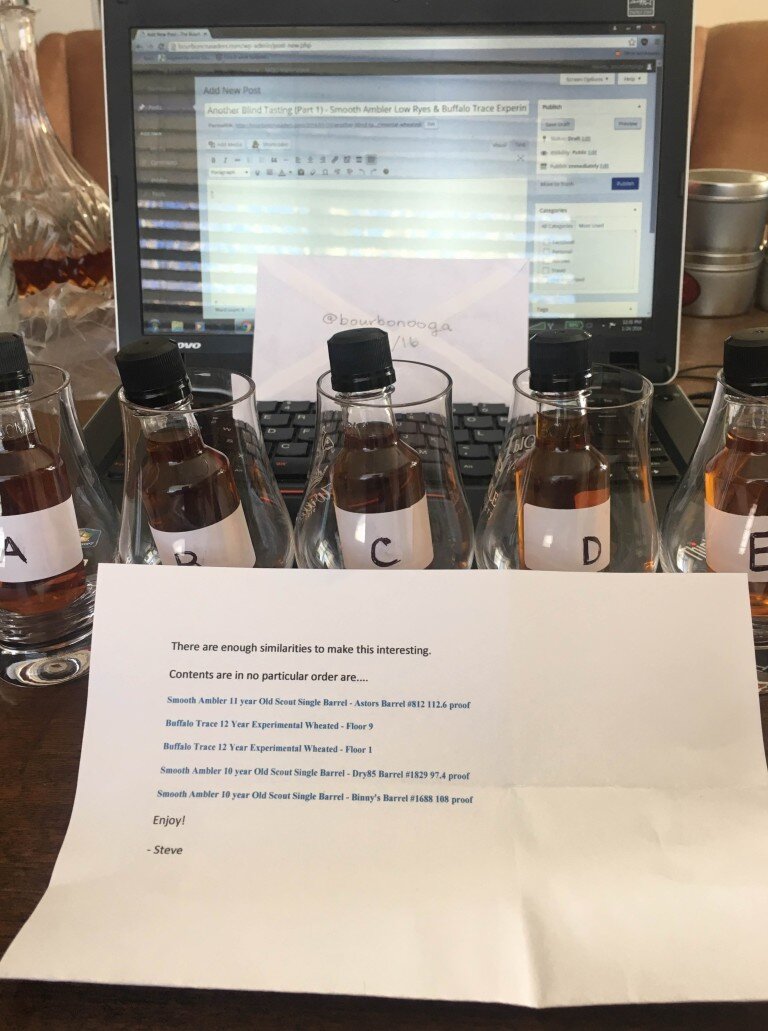 As you can see from the picture above, I know ahead of time that the five bourbons are, in no particular order:
As you can see from the picture above, I know ahead of time that the five bourbons are, in no particular order:
- Smooth Ambler Old Scout 11 Year Old - Astor's Single Barrel #812 (112.6 proof);
- Buffalo Trace Experimental Collection - 12 Year Old Wheated Bourbon from Floor #9 (90.0 proof);
- Buffalo Trace Experimental Collection - 12 Year Old Wheated Bourbon from Floor #1 (90.0 proof);
- Smooth Ambler Old Scout 10 Year Old - Dry85 Single Barrel #1829 (97.4 proof); and
- Smooth Ambler Old Scout 10 Year Old - Binny's Single Barrel #1688 (108.0 proof).
BackgroundI have had the experimental wheated collection before during another two-part blind challenge made possible by another of Steve's friendly whiskey bombs. I cataloged my results on my Twitter account (@bourbonooga) back in late May and mid June 2015. That blind challenge involved five different wheated bourbons from Buffalo Trace, and I correctly picked during both rounds each of Floors #1, #5 and #9. Hopefully, I have similar success in the first part of this blind challenge. I suspect that the key will be to identify either a strong wheated bourbon or Buffalo Trace characteristic, and, if I can spot the two wheated bourbons correctly, I will need to then think about which one has that mustier Buffalo Trace Warehouse C funk that would likely mean it is Floor #1 or which one has more oak or boldness throughout that would likely mean it is Floor #9.I have had several Smooth Ambler Old Scout products, but I have not had any of the barrels involved in this tasting. I currently have two 9 year old Smooth Ambler Old Scout single barrels--one selected by McScrooge's (Barrel # 48.5% abv) and one released by Smooth Ambler (Barrel #1889, 55.9% abv). I suspect that proof and possibly a rye spice/heat bite will be the key to identify whether a pour is one of the low rye Smooth Ambler bourbons or one of the wheated Buffalo Trace bourbons.MethodologyIn Part 1, I will pour half of each sample (25mL) and simply taste through each and make my guesses. I will not open the sealed answer key until after completing Part 2. For Part 2, which will be done the very next day, I have asked my wife to randomize samples A-E, and I will try to then guess which pour was which letter from the previous day. Therefore, Part 1 is a test upon my ability to guess a particular whiskey from a known list using taste, deductive reasoning and (some) palate memory (re: Floors #1 and 9), and Part 2 is a test upon my palate memory a day apart.
Notes for Part 1Sample ASample A is considerably darker than all of the other samples.Sample A smells rich and decadent. The legs take forever to slide down, and they seem to rather stick at the whiskey line and sprout thick whiskey tears that cling to the glass like icicles than to glide back down into the whiskey pool like usual. I pick up oak, caramel, pepper, spicy mustard and a little bit of dark chocolate. Based on nose alone, Sample A is head and shoulders above the others.Sample A tastes great. Lots of oak and caramel working with rich, warm dessert flavors like cinnamon, vanilla and chocolate.Sample A finishes all over the tongue, with a slight bitterness at the back roof of the mouth. The finish is rather long with more tingling in my mouth than down my gullet. It is mostly oak. It is a little sour and salty. I am most reminded of those chocolate and hazelnut filled wafer sticks (like Pepperidge Farm's Pirouette sticks).The proof on Sample A is definitely higher than Sample B.Sample BSample B is not as dark as Sample A, but they are more similar to each other than Sample C and Sample E are to each other. However, Sample B and Sample D are about as similar to each other as Sample C and Sample E.Sample B starts out with some acetone and marker, but there is also some red berry and uncharred oak. The oak comes across more like a higher-aged Elijah Craig (18 or 21 year bottles). I am also smelling cinnamon red hots and honey. Hiding behind the acetone is a bit of almond and marshmallow. The legs are slow and thin, but there are not many legs.Sample B tastes better than it smells. I still get acetone as I go in for a sip, but the flavors are much more like a muted wheat whiskey. Grain flavors are muted, and I get some cherry and vanilla.The finish is short and hard to place anything by the time it is gone.Sample CSample C is the lightest of all of the samples, but it is close in color to Sample E.Sample C has more caramel than Samples A and B. I am not getting much other than caramel, oak and leather. It smells thin, and the legs move quickly down the glass despite being thick.Sample C tastes interesting. I would not have guessed this was a bourbon. It almost tastes like a blended scotch. Lots of honey and a bite of spice. This also tastes the youngest of the group because I get a lot grain character that has not been worked off with the aging process. I know everything is at least 10 years old, but I would have pegged this at 6-8 years without seeing the list.The finish tastes like a Buffalo Trace warehouse smells, which is only adding confusion. But, I know there are two Buffalo Trace wheated bourbons, and Samples B and E taste so similar when compared to Sample C. Sample C is an outlier in this group of five whiskies.The proof seems lows.Sample DMost like Sample B's color.Sample D initially reminds me of Sample A. After a few minutes of air, it actually starts to smell a lot like Sample C.Sample D tastes great. I get similar warm, rich dessert flavors like Sample A, but those flavors are not as intense.The finish is square on the center of the tongue and no bitterness. The finish is relatively long--not as long as Sample A, but certainly longer than Samples B and C, and I get charred oak, pepper spice and almost like that MGP rye dill pickle flavor.Sample ESample E is light and similar to Sample C.Sample E initially reminds me of Sample B. There is an instant hit of green oak and red berry. This one has less acetone at the front. It is interesting that this and Sample B could be Buffalo Trace wheated bourbons because if I did not see the list my nose would be leading me toward whether one is Elijah Craig 18 and the other is Elijah Craig 21. After a few minutes of air, I pick up buckwheat pancakes and maple syrup.Sample E is very similar to Sample B on the taste, but it is a bit richer in flavor--there is more oak, more caramel, and the red fruit is brighter and more in your face.The finish on Sample E is slightly longer than Sample B. I even get a bit of toasted marshmallow and almond on the finish. The finish may be the best part of this whiskey.The proof seems higher than Sample B, but if this is Buffalo Trace and they are the same proof, then I attribute the extra kick on this one to more charred oak coming up.All of this means that I think this would be Floor #9 instead of Floor #1 if Samples B and E are the Buffalo Trace wheated bourbons, as I suspect.Guesses for Part 1Sample A - Clearly the best nose. The best taste, and either the best finish or second-best finish. Sample A tasted like it had the highest or second highest proof. I guess that this is the Smooth Ambler Binny's pick. Really, this was a coin toss between the Binny's and Astor's based on proof and the fact that each pick good private barrels.Sample B - The worst nose. Probably 4th in taste and 5th in finish. I guess that this is Buffalo Trace Floor #1.Sample C - Between this and Sample D for runner-up on nose. The taste is dead last. The finish is middle of the pack or maybe 4th. I guess that this is the Smooth Ambler Dry85 pick.Sample D - Possible runner-up on nose with Sample C. The runner-up on taste. The finish either 1st or 2nd. Sample D tasted like it had the highest or second highest proof. I guess that this is the Smooth Ambler Astor's pick. Really, this was a coin toss between the Binny's and Astor's based on proof and the fact that each pick good private barrels.Sample E - Second to worst nose. A better taste (probably 3rd). The finish is probably middle of the pack or 4th. I guess that this is Buffalo Trace Floor #9.Bottom LineI think Samples A and D are a step ahead of the other three to the tune of at least 0.5-1.0 points on my scale if I had more time to do a full taste and ranking. Sample A was very, very good, and I think I am going to need to hunt down a bottle. Off the top of my head, I could see this scoring anywhere from 8.0 to 9.0 (yes) on my scale. Sample D would be more like 7.5 to 8.0. Sample B came in last, but it was still a good bourbon and likely would fall in the 6.5 to 7.0 range in my scale. Sample D and E would rank similarly. These were not bad or even average bourbons. Above average across the board. I thought that the Buffalo Trace wheated bourbons would win the day (and that still may be the case), but I get the feeling that my two favorites are Smooth Ambler picks that are just bolder and more in your face. Plus, wheated bourbons tend to lack the rich dessert character that I have grown to prefer in my bourbons.Going into Part 2, I would say that Samples B and E should be easy to remember on smell, and Sample A should be easy to remember on taste and finish. I am going to look for Sample C by looking for that weird non-bourbon taste.
The "Wife is Out of Town Blind Challenge" Samples F-J / Results and Debriefing
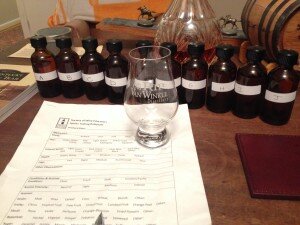 As you can read HERE, I recently did a 10-day/10-sample blind challenge. After posting my results for the first five samples, this post will cover my results for the second set of samples and the final results with a debriefing.Moving on to Sample F. . .After a two ounce pour, I would rank Sample F in the 8.75 to 9.0 range.Sample F Scoresheet - PDFSample F Picture - InstagramMoving on to Sample G. . .After a two ounce pour, I would rank Sample G in the 8.0 to 8.5 range.Sample G Scoresheet - PDFSample G Picture - InstagramMoving on to Sample H. . .After a two ounce pour, I would rank Sample H in the 6.75 to 7.25 range.Sample H Scoresheet - PDFSample H Picture - InstagramMoving on to Sample I. . .After a two ounce pour, I would rank Sample I in the 6.5 to 7.0 range.Sample I Scoresheet - PDFSample I Picture - InstagramMoving on to Sample J. . .After a two ounce pour, I would rank Sample J in the 6.0 to 6.5 range.Sample J Scoresheet - PDFno picture of Sample J
As you can read HERE, I recently did a 10-day/10-sample blind challenge. After posting my results for the first five samples, this post will cover my results for the second set of samples and the final results with a debriefing.Moving on to Sample F. . .After a two ounce pour, I would rank Sample F in the 8.75 to 9.0 range.Sample F Scoresheet - PDFSample F Picture - InstagramMoving on to Sample G. . .After a two ounce pour, I would rank Sample G in the 8.0 to 8.5 range.Sample G Scoresheet - PDFSample G Picture - InstagramMoving on to Sample H. . .After a two ounce pour, I would rank Sample H in the 6.75 to 7.25 range.Sample H Scoresheet - PDFSample H Picture - InstagramMoving on to Sample I. . .After a two ounce pour, I would rank Sample I in the 6.5 to 7.0 range.Sample I Scoresheet - PDFSample I Picture - InstagramMoving on to Sample J. . .After a two ounce pour, I would rank Sample J in the 6.0 to 6.5 range.Sample J Scoresheet - PDFno picture of Sample J
THE RESULTS ARE IN. . .
Sample A:
I guessed Fighting Cock 6yr as my primary guess and Wild Turkey 101 as my backup guess despite thinking that the nose was leading me to Knob Creek 120 (McScrooge's).
The actual result? KNOB CREEK 120 (McSCROOGE'S)
Sample B:
I guessed Willett Family Estate Barrel #6430 (11yr, 12/15 gift shop release) as my primary guess and Smooth Ambler Old Scout (McScrooge's) despite thinking that the nose was all over Four Roses with all of the fruit I smelled.
The actual result? VERY OLD BARTON 100 6YR
Sample C:
I guessed Maker's Mark Cask Strength as both my primary and backup guesses because of how strongly I picked up banana and esthers.
The actual result? NOAH'S MILL 15-18
Sample D:
I guessed Elijah Craig Barrel Proof Release #7 (128.0 proof) as my primary guess and Willett Family Estate Barrel #200 (10yr, 4/15 gift shop release) as my backup guess. This pour screamed high proof Heaven Hill.
The actual result? ELIJAH CRAIG BARREL PROOF RELEASE #7
Sample E:
I knew I was on to Four Roses. I guessed an OESK ME (9yr9mo, 2/15 gift shop release) as my primary guess and the Bourbon Crusaders OESK EN (9yr7mo, 4/15 Joyal's Liquors release) as my backup guess.
The actual result? FOUR ROSES 2013 LIMITED EDITION SINGLE BARREL (OBSK - BS 3-3L)
Sample F:
I knew I was on to Four Roses. I guessed the 2015 Limited Edition Small Batch as my primary guess and the BoomTown! OESK EN (9yr10mo, 10/15 release) as my backup guess. I thought the Four Roses was softer than OB mashbills and the proof was rather low, but the pour was more complex than usual. I felt pretty confident in either of my two guesses. This pour made me so happy I decided to do a little sketch.
The actual result? FOUR ROSES 2014 LIMITED EDITION SMALL BATCH
Sample G:
I knew again I was on to Four Roses, and I was starting to get worried that my wife closed out all of the other pours with Four Roses as well. I guessed the Bourbon Crusaders OBSV JE (9yr2mo, 9/15 Joyal's Liquors release) as my primary guess and the 2015 Limited Edition Small Batch as my backup guess.
The actual result? BOURBON CRUSADERS OESK EN (9YR10MO, 9/15 JOYAL'S LIQUORS RELEASE)
Sample H:
I picked up early on Buffalo Trace type characteristics that had me thinking about Old Weller Antique and Elmer T. Lee. Ultimately, I decided that the red fruit and higher proof was more wheater than Ancient Age mashbill so my primary guess was Old Weller Antique (standard) and my backup guess was Old Weller Antique (McScrooge's). Although, being set on a wheater, I had some internal struggle about whether this was "Poor Man's Pappy" as I had in my last blind challenge poured by my wife.
The actual result? OLD WELLER ANTIQUE 107 (STANDARD)
Sample I:
I thought I was back on to more Buffalo Trace juice, and I guess Poor Man's Pappy as my primary guess and Elmer T. Lee as my backup guess.
The actual result? ELMER T. LEE
Sample J:
Just like the streak of Four Roses, I was sure I was on to Buffalo Trace again. My primary guess was Elmer T. Lee because of the pepper. However, there was something I was not that familiar with so I also thought of a PH Ambler Contravention vatting I received from @jesteva62755 that is a blend of Parker's Heritage 8 and Smooth Ambler Contravention.
The actual result? BUFFALO TRACE
THE DEBRIEFING
With the final results in, I scored slightly worse than I expected. I got two pours exactly right, one backup guess right and all of the Four Roses origin pours correct. I allowed my taste and gut to lead me astray on the first pick with the Knob Creek 120 (McScrooge's) that might have set the tone for the rest of the challenge. I also whiffed rather hard on Samples B and C.
What I learned from this challenge is A) I drink Four Roses too much, but not enough, B) I need to put more attention to 10yr and younger Beam and Heaven Hill products and C) I [fortunately] have much more work to do.
What I was most surprised by in this challenge are the results from Sample C (Noah's Mill 15-18) and Sample E (Four Roses 2013 Limited Edition Single Barrel). The Noah's Mill did not taste like my last imprint (read: better). The 2013 Limited Edition Single Barrel was a letdown (relatively - with its 8.25 to 8.75 blind range score) considering it was an immovable feature in my Top 3 All Time list. My one and only bottle is now 2.5 years old and on its last 2 or 3 pours so I am saddened to think this one has lost a bit of sheen.
The ten pours ranked from best to worst as follows:
- Four Roses 2014 Limited Edition Small Batch;
- (tie) Elijah Craig Barrel Proof Release 7 (128.0 Proof);
- (tie) Four Roses 2013 Limited Edition Single Barrel;
- Bourbon Crusaders Four Roses OESK EN 9yr10mo 9/15 Joyal's Liquors release;
- Noah's Mill 15-18;
- Very Old Barton 100 6yr;
- Old Weller Antique 107 (standard);
- Elmer T. Lee;
- Buffalo Trace; and
- Knob Creek 120 (McScrooge's).
In conclusion, it appears that I ranked my picks rather accurately along the lines of limited edition (1 and 3), higher-end regular releases (2 and 5) and great, recent batches (4 and 5) being better than standard releases (7 through 9), with the only outlier being the Knob Creek 120 "Hand Selected For" (not "By") McScrooge's, which in a prior Knob Creek 120 blind sample finished 4th of 5 different picks and got a C/C- rating. Nevertheless, I cannot stop until I get a bowl a 300.
The "Wife is Out of Town 10-Day Blind Challenge" / Overview & Samples A-E
 I enjoy doing blind tastings. I think it is interesting when you taste something blind and miss that one tell-tale key to the answer--Jim Beam and peanut, Maker's Mark and banana/ester/Belgian beer or Four Roses and mint/citrus/Juicy Fruit gum. That missing tell-tale key is the proof that more work is needed, and work in this case is tasting more whiskey. If anyone reading this follows me on Twitter or Instagram (@bourbonooga), you might remember a few recent blind tastings that I have done: a four-sample tasting of different private Knob Creek 120 picks; a five-sample Buffalo Trace 12 year old wheated horizontal done twice with a few weeks in between the two tastings; a fourteen-sample out of then twenty-four open bottle free-for-all; and most recently a four-sample out of then fifty-eight open bottle free-for-all spread out over four consecutive nights. I had success in both blind tastings of the Buffalo Trace 12 year old wheated horizontal correctly guessing three of the five in each tasting and missing a perfect score by mixing two of my bottom three pours each time. On the other hand, I failed rather miserably in my recent four-sample free-for-all by whiffing completely the first three nights and having luck the final night by guessing that the pour was Weller 12 when it was in fact a blend of Weller 12 and Old Weller Antique 107.Now, my wife has left me and the dog to fend for ourselves for ten days in colder weather. Before she left, however, I asked her to pour another free-for-all blind tasting set, but on steroids. This post and the next are devoted to a ten-sample free-for-all out of now sixty open bottles, with one pour each day or night. I will not know the answers until the end as my wife holds the Rosetta Stone for this challenge.My current open bottle inventory covers a wide swath of whiskey with high-rye bourbon, low-rye bourbon, wheated bourbon, wheat whiskeys, rye whiskeys (Canadian and American), scotch (peated and non-peated), Buffalo Trace, Four Roses, Heaven Hill, Jim Beam, MGP, Willett, Wild Turkey, Barton, homemade vats, vats from generous friends and the open bottles range from four years in age to twenty-two years in age. Four Roses dominates my liquor cabinet, but I have sixteen different bottles of Four Roses open so pinpointing the exact recipe or small batch will be difficult even if Four Roses is the most likely to be represented in this blind challenge making up 27% of my open bottle list.I will use for each pour the Society of Wine Educations Spirits Tasting Rationale score sheet simply because I find it to contain a great section on aromas and a sufficient section on taste and finish, with the added bonus that it means I have less writing to do. Instead, I can be lazy and upload PDFs of my score sheets.Moving on the Sample A. . .After a two ounce pour, I would rank Sample A in the 4.75 to 5.25 range.Sample A Scoresheet - PDF
I enjoy doing blind tastings. I think it is interesting when you taste something blind and miss that one tell-tale key to the answer--Jim Beam and peanut, Maker's Mark and banana/ester/Belgian beer or Four Roses and mint/citrus/Juicy Fruit gum. That missing tell-tale key is the proof that more work is needed, and work in this case is tasting more whiskey. If anyone reading this follows me on Twitter or Instagram (@bourbonooga), you might remember a few recent blind tastings that I have done: a four-sample tasting of different private Knob Creek 120 picks; a five-sample Buffalo Trace 12 year old wheated horizontal done twice with a few weeks in between the two tastings; a fourteen-sample out of then twenty-four open bottle free-for-all; and most recently a four-sample out of then fifty-eight open bottle free-for-all spread out over four consecutive nights. I had success in both blind tastings of the Buffalo Trace 12 year old wheated horizontal correctly guessing three of the five in each tasting and missing a perfect score by mixing two of my bottom three pours each time. On the other hand, I failed rather miserably in my recent four-sample free-for-all by whiffing completely the first three nights and having luck the final night by guessing that the pour was Weller 12 when it was in fact a blend of Weller 12 and Old Weller Antique 107.Now, my wife has left me and the dog to fend for ourselves for ten days in colder weather. Before she left, however, I asked her to pour another free-for-all blind tasting set, but on steroids. This post and the next are devoted to a ten-sample free-for-all out of now sixty open bottles, with one pour each day or night. I will not know the answers until the end as my wife holds the Rosetta Stone for this challenge.My current open bottle inventory covers a wide swath of whiskey with high-rye bourbon, low-rye bourbon, wheated bourbon, wheat whiskeys, rye whiskeys (Canadian and American), scotch (peated and non-peated), Buffalo Trace, Four Roses, Heaven Hill, Jim Beam, MGP, Willett, Wild Turkey, Barton, homemade vats, vats from generous friends and the open bottles range from four years in age to twenty-two years in age. Four Roses dominates my liquor cabinet, but I have sixteen different bottles of Four Roses open so pinpointing the exact recipe or small batch will be difficult even if Four Roses is the most likely to be represented in this blind challenge making up 27% of my open bottle list.I will use for each pour the Society of Wine Educations Spirits Tasting Rationale score sheet simply because I find it to contain a great section on aromas and a sufficient section on taste and finish, with the added bonus that it means I have less writing to do. Instead, I can be lazy and upload PDFs of my score sheets.Moving on the Sample A. . .After a two ounce pour, I would rank Sample A in the 4.75 to 5.25 range.Sample A Scoresheet - PDF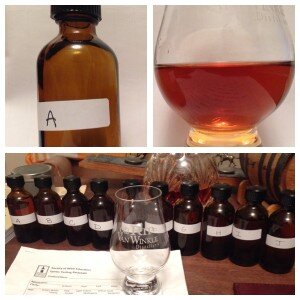 Moving on the Sample B. . .After a two ounce pour, I would rank Sample B in the 7.0 to 7.25 range.Sample B Scoresheet - PDF
Moving on the Sample B. . .After a two ounce pour, I would rank Sample B in the 7.0 to 7.25 range.Sample B Scoresheet - PDF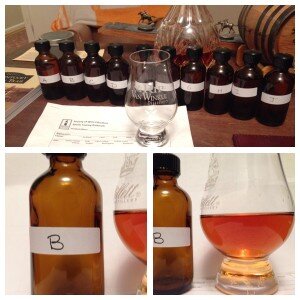 Moving on the Sample C. . .After a two ounce pour, I would rank Sample C in the 7.25 to 7.75 range.Sample C Scoresheet - PDF
Moving on the Sample C. . .After a two ounce pour, I would rank Sample C in the 7.25 to 7.75 range.Sample C Scoresheet - PDF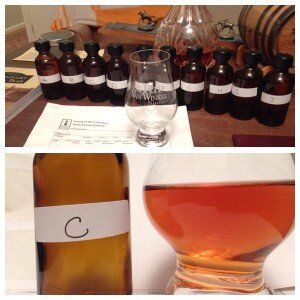 Moving on the Sample D. . .After a two ounce pour, I would rank Sample D in the 8.25 to 8.75 range.Sample D Scoresheet - PDF
Moving on the Sample D. . .After a two ounce pour, I would rank Sample D in the 8.25 to 8.75 range.Sample D Scoresheet - PDF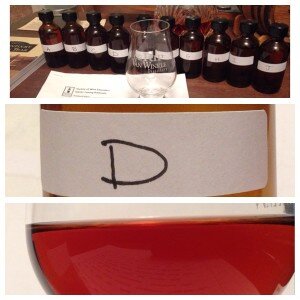 Moving on the Sample E. . .After a two ounce pour, I would rank Sample E in the 8.25 to 8.75 range.Sample E Scoresheet - PDF
Moving on the Sample E. . .After a two ounce pour, I would rank Sample E in the 8.25 to 8.75 range.Sample E Scoresheet - PDF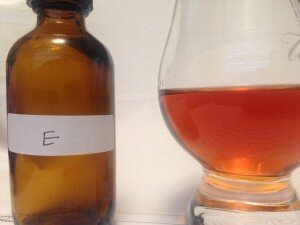 Stay tuned later this week for the final 5 score sheets and, ultimately, the big reveal.@bourbonooga's rubric:9.5-10.0 bourbon basically does not exist in my scoring system. It is a figure left for the life-altering bourbons.9.0-9.5 bourbon is as best as they come.8.5-9.0 bourbon is fantastic, and it is a mark that a limited edition release should hit. Obviously, not all do.8.0-8.5 bourbon is a bourbon that likely has one superb feature and above average remainders, or it is a bourbon that is more than above average across the board. This is a mark that a limited edition release must hit to avoid underperformance.7.0-8.0 bourbon is a bourbon that is probably above average across the board. There may be one close to average aspect about it. This is the worst bourbon that I want to pour each night when I am rich.6.0-7.0 bourbon is a bourbon with nearly every facet near average, but not yet average. Expect slightly less reviews to fall here.5.0-6.0 bourbon is average bourbon. Expect most reviews to fall here.4.0-5.0 bourbon is a bourbon with nearly every facet near average, but on the wrong side of average. Expect most reviews to fall here.3.0-4.0 bourbon is a bourbon with probably one average or near average aspect, with the others being below average. Expect slightly less reviews to fall here.2.0-3.0 bourbon is solidly below average bourbon. I suspect I could be reviewing a few of these bourbons.1.0-2.0 bourbon is bad. I hope I do not have to review many bourbons in this category.0.0-1.0 bourbon should be avoided at all costs. I highly doubt I ever review a bourbon in this category.
Stay tuned later this week for the final 5 score sheets and, ultimately, the big reveal.@bourbonooga's rubric:9.5-10.0 bourbon basically does not exist in my scoring system. It is a figure left for the life-altering bourbons.9.0-9.5 bourbon is as best as they come.8.5-9.0 bourbon is fantastic, and it is a mark that a limited edition release should hit. Obviously, not all do.8.0-8.5 bourbon is a bourbon that likely has one superb feature and above average remainders, or it is a bourbon that is more than above average across the board. This is a mark that a limited edition release must hit to avoid underperformance.7.0-8.0 bourbon is a bourbon that is probably above average across the board. There may be one close to average aspect about it. This is the worst bourbon that I want to pour each night when I am rich.6.0-7.0 bourbon is a bourbon with nearly every facet near average, but not yet average. Expect slightly less reviews to fall here.5.0-6.0 bourbon is average bourbon. Expect most reviews to fall here.4.0-5.0 bourbon is a bourbon with nearly every facet near average, but on the wrong side of average. Expect most reviews to fall here.3.0-4.0 bourbon is a bourbon with probably one average or near average aspect, with the others being below average. Expect slightly less reviews to fall here.2.0-3.0 bourbon is solidly below average bourbon. I suspect I could be reviewing a few of these bourbons.1.0-2.0 bourbon is bad. I hope I do not have to review many bourbons in this category.0.0-1.0 bourbon should be avoided at all costs. I highly doubt I ever review a bourbon in this category.
Non Satis Mundus Habet Veratatem
Non Satis Mundus Habet Veratatem.Non Satis Mundus Habet Veratatem. Non Satis Mundus Habet Veratatem. Non Satis Mundus Habet Veratatem. Non Satis Mundus Habet Veratatem. Non Satis Mundus Habet Veratatem. Non Satis Mundus Habet Veratatem. Non Satis Mundus Habet Veratatem. Non Satis Mundus Habet Veratatem. Non Satis Mundus Habet Veratatem. Non Satis Mundus Habet Veratatem. Non Satis Mundus Habet Veratatem. Non Satis Mundus Habet Veratatem.Non Satis Mundus Habet Veratatem.Non Satis Mundus Habet Veratatem. Non Satis Mundus Habet Veratatem. Non Satis Mundus Habet Veratatem. Non Satis Mundus Habet Veratatem. Non Satis Mundus Habet Veratatem. Non Satis Mundus Habet Veratatem. Non Satis Mundus Habet Veratatem. Non Satis Mundus Habet Veratatem. Non Satis Mundus Habet Veratatem. Non Satis Mundus Habet Veratatem.Non Satis Mundus Habet Veratatem.Non Satis Mundus Habet Veratatem. Non Satis Mundus Habet Veratatem. Non Satis Mundus Habet Veratatem. Non Satis Mundus Habet Veratatem. Non Satis Mundus Habet Veratatem. Non Satis Mundus Habet Veratatem. Non Satis Mundus Habet Veratatem. Non Satis Mundus Habet Veratatem. Non Satis Mundus Habet Veratatem. Non Satis Mundus Habet Veratatem.
